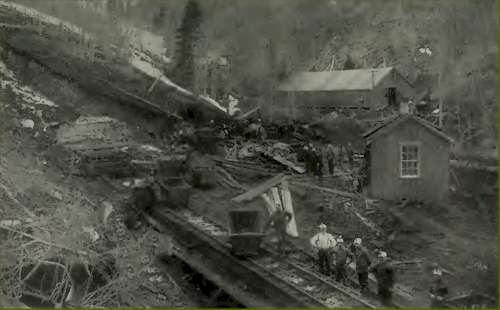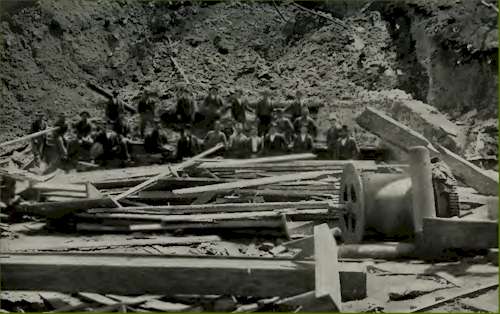May 1st 1900,
Number Four Mine
May Day or
Dewey Day, dawned bright and clear, when about two hundred
miners left Scofield for the mines in the miner's coach that is
run back and forth at the change of shifts, to the mines of the
Pleasant Valley Coal Company at Winter Quarters. Every one of
the men that were soon to meet death in its most horrible form
were feeling in the best of spirits as evidenced by the pleasant
joke that was bandied back and forth through the coach. What had
they to fear, were they not working in one of the safest coal
mines situated in the coal region? Each one was looking' forward
to the evening when there was to be a dance in the new Odd
Fellow's Hall, and their children were to have a celebration in
honor of the Hero of the Battle of Manilla. All were merry and
joyous. The springtime of the year was at hand, the trees were
commencing to put on their garb of green and all nature was
smiling with the first warm days of the most gladsome part of
the whole year.
Nearly every
man was at his post of duty in the mine, when from some cause or
other, a most terrific explosion took place and all was changed
in the twinkling of an eye. The lips that were breathing words
of hope and encouragement of a few hours before were now hushed
and cold in death. The lips that had kissed their wives and
children the customary goodbye, and the ever returning response
from the loved ones as they wished their husbands and fathers a
quick return, would never more be heard to utter words of love.
At about fifteen minutes past ten o'clock the surrounding
country was startled by an explosion, but as it was Dewey day
nearly every one supposed that the noise was from someone
setting off a blast in honor of the day. But bye and bye there
were seen women hurrying towards the mine and by their blanched
faces one could read that there was something amiss at the
mines. Reports came down that Number Four had exploded, but this
was not believed as this mine in particular was supposed to be
the safest mine of all of the Company's mines. But disaster dire
and dreadful had overtaken Number Four, and all that were not
working hurried to the opening as fast as possible there to be
greeted by a sight of death and destruction such as one rarely
if ever sees in a lifetime. But if the explosion has produced
such havoc on the outside, what can be the condition upon the
inside where the miners are confined with no chance of escape,
caught like rats in a trap? No hope to recover anyone alive, no
hope to ever look upon the face of those entombed, no hope of
ever hearing loving words from lips now charred and blackened in
the embrace of death.

Wreck at Number Four
Barn across the Gulch
On the top of
the incline at the mouth of the mine, where the drums that let
the cars down the incline were housed, nothing remained of the
house but the boards broken and twisted. By some lucky chance or
other the engineer was out assisting in replacing a car upon the
track that had been derailed, and although scratched and bruised
was still alive and able to take care of himself. One of the men
that assists in pushing the loaded trip over the knuckle was
found with his foot crushed, his shoulder out of place and
severe injuries were sustained in other parts of his body. The
assistant helper was found with his jaw broken and the side of
his face crushed. The next man to be met had one leg broken, one
arm broken and severely injured about his body. These men were
immediately taken home by a few of the men that had arrived by
this time and we hastened to the mouth of the mine, where one
horse was found dead but his driver could not be seen until
someone looking' down the gulch saw the form of someone,
supposed to be the driver, John Wilson. A few of the men hurried
to his side and found that life was not yet extinct, although he
had been blown eight hundred and twenty feet, by actual
measurement. He was tenderly picked up and conveyed to his home
where it was found that the back part of his skull had been
crushed, besides a stick or splinter had been driven downward
through his abdomen. He was in a critical condition and no one
supposed he would live to be carried home, but, strange to
relate, he has recovered rapidly and although he will never be
able to do a day's work again he is up and feeling quite well at
present. A relief committee was headed by T. J. Parmley,
Superintendent of the mine, and they started for the levels of
Number Four through Number One, there being inside connections,
but were driven back by the terrible afterdamp that had by this
time reached the lower levels in Number One. Bernard Newren, a
young man working on the outside at the mine, went with the
relief committee on its errand of mercy but was carried out, he
having been overcome by the deadly damp.

Wreck at Powerhouse
Andrew Hood,
Foreman in Number One mine, was a few minutes later assisted
out, he having been overcome in the same way. He went to his
home, but realizing the horrible disaster he tried again to
enter the mine but had not recovered sufficiently. (The route by
the way of Number One having been found impracticable on account
of the afterdamp, the relief committee hurried to the mouth of
Number Four where the attempt was again made to enter the
inferno that had been raging within.
Attempt after
attempt was made, and after about twenty minutes delay, during
which the horse and timbers that obstructed the mouth of the
mine was cleared away, the relief committee was able to follow
the air and the actual work of rescue began. The first one to be
met was Harry Betterson, supposed at the time to be John Kirton
and being still alive was brought to the surface where he was
found to be burned beyond recognition. J He was taken to the
boarding house but died during the first part of the night. The
next one to be found was William Boweter and although sitting
among the dead was found to be alive, although hardly conscious.
After being assisted to his feet he walked out, with slight
help. Hope had been entertained up to this time that some of the
men would be found still living, but those mentioned above were
the only ones that were brought out alive. Roll after roll of
canvas was brought, and brattices were fixed up on the inside to
force the air into one level at a time in order that the
rescuing party could force their way through the mine in the
hope of finding someone still alive. But the farther the
rescuers went the more apparent become the magnitude of the
disaster. Men were piled in heaps as there were not enough men
to carry out the dead as fast as found. The miners at Clear
Creek mine by this time began to arrive, and their assistance
came none too soon, for there was plenty of work for all. The
new arrivals began to carry out the bodies which were placed in
the Company's barn across the ravine, where they were tagged as
fast as recognized. The heartrending shrieks of the wives and
relatives of the dead miners were not heard at this mine, but
when anyone would go down the incline they would be met with
lamentations that would cause even the hardest hearted men to
shed tears. Women asking if their husbands or fathers had been
brought out or no, children crying for the parent that was still
within the mine. Many who had relatives working in Number One,
were not so much concerned at first, as it was supposed by those
upon the outside that the men in that mine had not been
affected, as the explosion had occurred in Number Four, but
their hopes were dispelled when the rescuers had passed from
Number Four into Number One. The first dead body carried out of
Number One was Roger Davis, a driver, who had been caught by
some of the flying debris. After this the bodies of Thomas
Livsey and his son William were found badly burned, almost
beyond recognition, but still alive. The dead then began to
arrive at the month of Number One by the car load, sometimes as
many as twelve bodies having been loaded upon one mine car. Then
it was when the horror of the situation began to dawn upon the
minds of the people on the outside of the ill-fated mine. Then
it was that the people realized that it was impossible to expect
anything but the burned or mangled body of the loved ones that
had entered the mine so light hearted that morning.
At the foot
of the short incline at Number One, where the props for the mine
are hauled up to the opening, is situated an old building, now
occupied by Mr. Edwards and used as a miner's boarding house.
This was utilized at once as a dead-house, and all of the dead
that came from Number One were carried down this short incline
and laid in the old boarding house. One of the employees of the
Pleasant Valley Coal Company, who had the duty of issuing coupon
books to the miners, Mr. C. Nix, was detailed by the Company to
take charge of the boarding house and try to identify the dead
as fast as they were carried out. As soon as one of the dead was
recognized Mr. Nix would place a tag upon the dead man's breast.
At one time, before the washing of the dead was commenced, there
were sixty-six lying in the receiving room.
Index

Source: History of the Scofield Mine
Disaster, by J. W. Dilley, The Skelton Pub. Co., Provo, Utah,
1900.
Editors Note: The I.. O. O. F. were very active in raising
money for the benefit of the widows and children along with the
Church of Jesus Christ of Latter-day Saints. This information is
included for historical value, it does not mean the people of
this project support these institutions.
|
![]()
![]()
